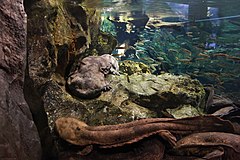Cryptobranchidae
| Giant salamanders Temporal range: Paleocene - Present,60–0 Ma |
|
|---|---|
 |
|
| Andrias japonicus | |
| Scientific classification | |
| Kingdom: | Animalia |
| Phylum: | Chordata |
| Class: | Amphibia |
| Order: | Urodela |
| Suborder: | Cryptobranchoidea |
| Family: |
Cryptobranchidae Fitzinger, 1826 |
| Genera | |
The Cryptobranchidae are a family of fully aquatic salamanders commonly known as the giant salamanders. A single species, the hellbender (Cryptobranchus alleganiensis) occurs in the eastern United States, while Asian species occur in both China and Japan. They are the largest living amphibians known today. The Japanese giant salamander (Andrias japonicus), reaches up to 1.44 m (4.7 ft), feeds on fish and crustaceans, and has been known to live for more than 50 years in captivity. The Chinese giant salamander (Andrias davidianus) can reach a length of 1.8 m (5.9 ft).
The family name is from the Ancient Greek krypto ("hidden"), and branch ("gill"), which refer to how the members absorb oxygen through capillaries of their side-frills, which function as gills.
Clade Pancryptobrancha (Cryptobranchidae + Ukrainurus)
Extant species in the family Cryptobranchidae are the modern-day members of a lineage that extends back millions of years; the earliest fossil records of a basal species date back to the Middle Jurassic and were found in volcanic deposits in northern China. These specimens are the earliest known relatives of modern salamanders, and together with the numerous other basal groups of salamanders found in the Asian fossil record, they form a firm base of evidence for the fact that "the early diversification of salamanders was well underway" in Asia during the Jurassic period. Little has changed in the morphology of the Cryptobranchidae since the time of these fossils, leaving researchers to note "extant cryptobranchid salamanders can be regarded as living fossils whose structures have remained little changed for over 160 million years."
As the fossil record for the Cryptobranchidae shows an Asian origin for the family, how these salamanders made it to the eastern US has been a point of scientific interest. Research has indicated a dispersal via land bridge, with waves of adaptive radiation seeming to have swept the Americas from north to south.
...
Wikipedia
